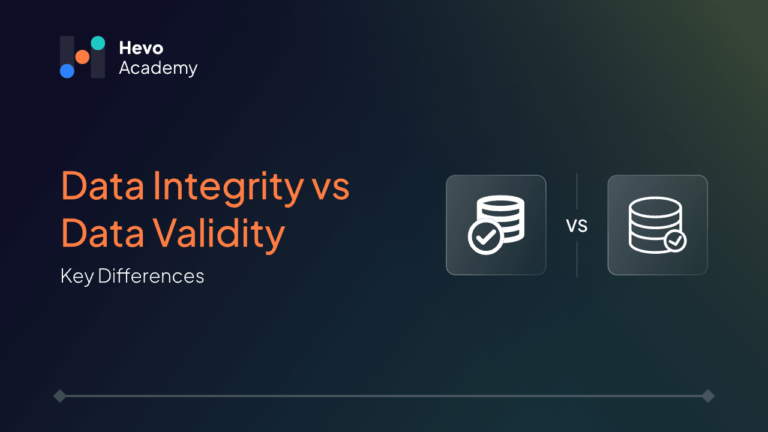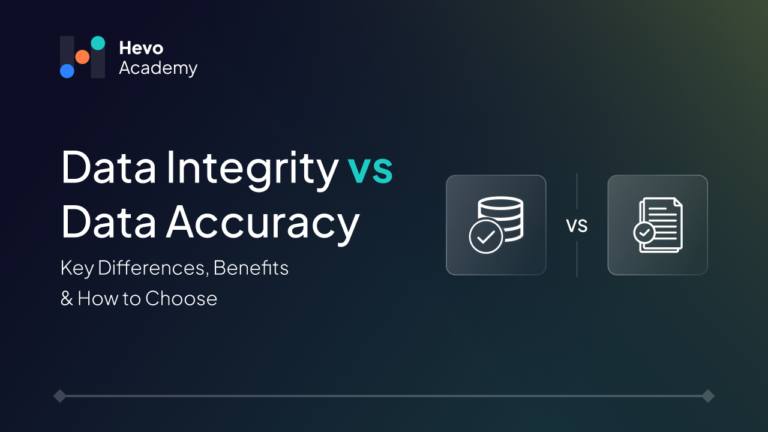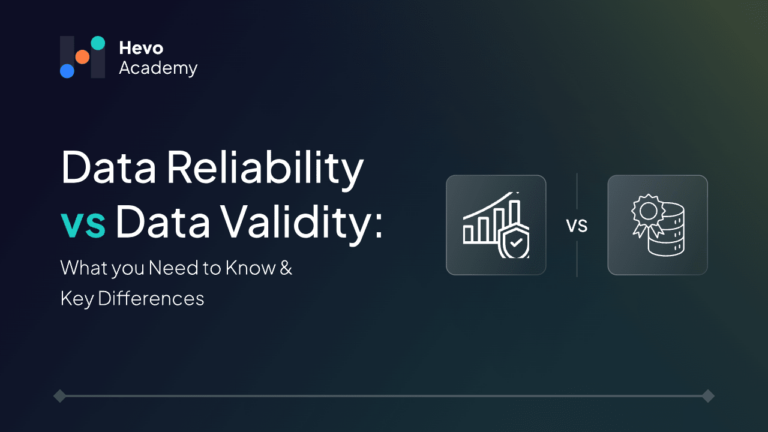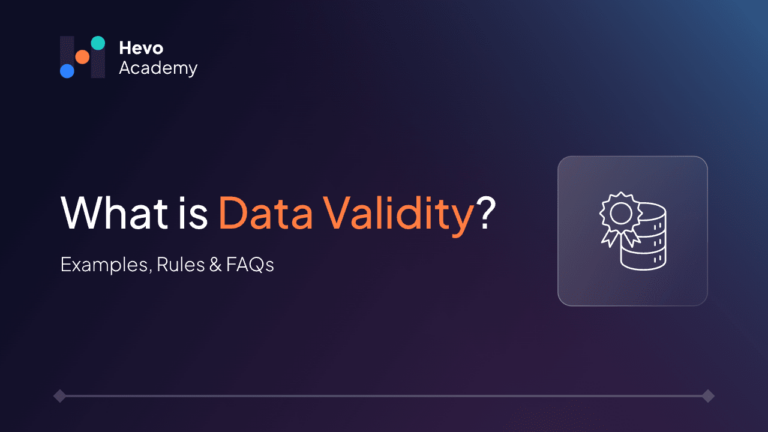Data integrity and data validity are the major concepts used interchangeably or confusing each other in data management. Both play a significant role in determining the accuracy and reliability of data; hence, it is a must to understand the differences between them and their various implications. Read this blog on Data Integrity vs Data Validity to know more.
Table of Contents
Let us understand them by an example.
Analogy: Baking cake
Data Integrity: Data integrity means ensuring the ingredients to bake a cake are correct, fresh, and consistent. If sugar is swapped with salt or eggs are spoiled, we won’t get freshly baked cake as expected. Similarly, if data is corrupted or altered, it can ruin the data’s reliability and accuracy.
Data Validity: It is like baking a cake; fresh ingredients are worthless unless in the right proportions. The cake will only be baked if the temperature and duration for baking are appropriate. Data validity is an assurance that the data fits the needed form and rules.
Example: Formatted correctly, but the actual measurements of the ingredients in terms of how many tablespoons or teaspoons, and baking at 500°F instead of 350°F will spell disaster. Similarly, data validity simply means that data conforms to predefined rules or forms, dates are valid, the numbers fall within some defined range, or the input is entered in the proper format.
Data integrity refers to the correctness of ingredients, undisturbed, and validity is the correctness of the recipe and measurements in baking a perfect cake. For data management, integrity refers to the fact that data is unchanged and true, while validity is that data is accurate, and in the right format so that it is worth reliable.
Here, Data validity requires data integrity, but integrity alone does not guarantee the validity of data.
Hevo allows you to easily connect your source to automate data migration without needing to write code. With Hevo, you can extract data transform it, and load it into a wide variety of destinations like Snowflake, Redshift, or BigQuery, ensuring real-time data synchronization and transformation.
What Hevo Offers:
- No-Code Platform: Simplifies setup with an intuitive, user-friendly interface.
- Automated Data Integration: Seamlessly moves data from 150+ sources.
- Real-Time Sync: Ensures continuous, real-time updates.
What is Data Integrity?
Data integrity is the process of maintaining consistency, accuracy, and trustworthiness of data throughout its life cycle, including storage, retrieval, and usage. It involves maintaining the correctness and completeness of data across the systems by avoiding malicious activity and unauthorized access to data and preventing data breaches or loss. Several factors, such as system failures, human errors, or data tempering, can impact data integrity.
How to maintain Data Integrity?
Data integrity requires robust systems, including data validation checks, security measures, and data quality checks. It involves establishing data governance policies around data quality and validations to maintain the integrity of data assets.
An organization can enhance data security and improve business decision-making by maintaining data integrity.
Methods:
- Backups – Taking a backup of data helps in the case of data loss or corruption. It restores data to its original state.
- Rules – Set rules on how the data is entered or ingested into the system.
- Access Control and Audit- Set up roles and access policies to define who can access certain resources in the system.
- Data Governance – Implement strong data governance practices to ensure data integrity by defining who is responsible for maintaining data accuracy, consistency, and reliability.
What is Data Validity?
On the other hand, data validity is the process of data conformity of predefined standards or algorithms and constraints.
Data validity is an essential component in data, making the data applied more reliable and usable. Organizations validate data against predetermined criteria to identify data errors, inconsistencies, and discrepancies that have been corrected. It doesn’t just improve the quality of data but accelerates the efficiency of data analysis and reporting.
How to maintain Data Validity?
Methods:
- Validation – Apply validation rules like if a phone should have specific formats or of certain length.
- Comparision – Compare the data with the source of truth. Automation can help validate and cross-verify data entering into the systems.
- Data cleaning – The process of identifying and correcting errors or inconsistencies within datasets. Data cleaning usually entails the deletion of duplicate entries, correction of typos, and standardization of data.
- Data profiling – The screening of patterns, trends, and anomalies through datasets. Those insights can be used to find possible inaccuracies or discrepancies in such a case.
Quick Tip: Strong data governance components, such as data quality monitoring and compliance checks, ensure that both integrity and validity are enforced consistently across data assets.
Data Integrity vs Data Validity: Key Differences
Both data integrity and validity are important data quality dimensions contributing to accurate, consistent, and dependable data across applications. They share the common goal of having accurate and reliable data, but the two have several key differences.
Data Integrity focuses on the overall accuracy and consistency of data; it sets a broader scope than just validating predefined constraints.
Data validity is more focused on data conformity with specific predefined rules and constraints.
Data Integrity vs Data Validity: Key similarities
1. Contribute to Data Quality
Data accuracy and data integrity are two of the most important components of data quality. As mentioned above, data quality encompasses many attributes, such as accuracy, consistency, completeness, and timeliness. High-quality data is accurate, consistent, and reliable, which will make organizations wise in their decisions and achieve their stated goals.
2. Regulatory Compliance
Data integrity and validity are essential to ensure that organizations adhere to standards and regulations in various industries. Take the financial services industry; here, the Sarbanes-Oxley Act, for instance, along with Basel III, demands organizations to ensure the accuracy and integrity of their financial information. Non-compliance would cost an organization dearly-mostly in terms of serious penalties and heightened supervision and reputational problems.
Quick Tip: Adhering to data quality standards helps maintain data integrity and validity, providing a foundation for trustworthy and reliable data.
Data Integrity vs Data Validity: What are the Benefits?
Benefits of Data Integrity
1. Reliable decision-making: The quality of data, that would be used for a particular decision-making, is accurate and reliable, thus a more informed and confident choice.
2. Data security: Data integrity safeguards against unauthorized access, breach of data, or tampering with data that may lead to better security concerning the protection of data and in turn ensure needed standards.
3. Better quality of data: Data integrity prevents data corruption and error thereby generally raising the overall data quality, and thus eliminating the possibility of wrong or outdated data.
4. Consistency and reliability: Data integrity measures ensure that data remains consistent; hence the same data will always return the same results from different applications and analyses. While integrity focuses on data completeness and consistency, data integrity vs data accuracy highlights the need for data to be both reliable and correct.
5. Increased user trust: Stakeholders and users tend to gain confidence in the data, thus leading to increased reliance on the organization’s systems and reports.
6. Improved data retention: One of the data integrity practices is taking regular backups, this means data is still available if hardware fails or the system crashes.
Want to dive deeper into data integrity best practices? Check out our blog to understand how to prevent data corruption and inconsistencies.
Benefits of data validity
1. Accurate analysis and reporting: Valid data provides accurate insights toward effective business decisions.
2. Operational efficiency: Valid data enhances operational efficiency by preventing time wastage in dealing with incorrect data. Valid data reduces the possibility of errors and their associated costs, such as fixing mistakes or lawsuit repercussions.
3. Increased customer satisfaction: With valid data, organizations are competent to provide data to clients that is more accurate and relevant, thereby increasing their satisfaction and loyalty.
4. Effective business processes: Valid data enables streamlined and efficient business processes instead of delaying the business processes on account of problems related to data.
Valid data ensures smooth data integration between systems and applications rather than possible conflict or inconsistency with data exchange between systems or applications.
Challenges in Data Validity and Integrity
Challenges of data integrity
- Huge volume and high velocity of data: With the emergence of big data, the cloud has solved the issues organizations face regarding data storage. However, data integrity issues exist. The probability of errors that can ensue increases with the volume and rate at which data are being created and modified.
- System complexity: Organizational data is distributed over many systems and databases with multiple entry points. Data integrity becomes difficult due to hundreds of entry points and usage. While many tools manage data quite easily while being embedded with rules and features, most legacy systems lack facilities, which adds extra burdens.
- Organizational culture: Lack of clear ownership of data creates issues in data governance.
Challenges in data validity
- Data entry errors
The most common sources of invalid data arise from many entry errors, including typographical errors, incorrect date formats, or even simply misentered values. These can greatly distort the findings of data analysis and outcomes.
- Incomplete or missing data
Another major concern is incomplete datasets. Data points may be missing due to data collection errors, failure in sending data, or incomplete extraction processes. These could yield biased analyses and unacceptable conclusions because the absent data might represent a sizeable portion of the study or business environment.
- Data duplication
Duplicate data usually emerges during the migration of systems or when merging datasets from different sources. Duplicate records inflate the numbers, give misleading analyses, and also incorrect business intelligence results.
- Inconsistency in data between the sources
Different systems collect or record the same data differently. Without correct data integration and reconciliation processes, they will cause a fractured view of data and faulty decision-making.
- Data decay over time
Data degeneration is the rate at which data loses some validity and accuracy with time due to environmental changes. For instance, customer preference data becomes invalid as market trends change.
- Impact of external environment on the quality of data
Regulatory change, technological advancement, or even a change in market conditions are other external factors that may influence data quality. Organizations ought to change their forms of managing data to validate their data.
Conclusion
The key to good data management is to understand the difference between the concepts of data integrity and data validity, the latter being a critical element toward achieving high-quality data delivery. Data integrity focuses on retaining data accuracy, consistency, and trustworthiness during its life cycle. Data validity ensures that data follows the pre-defined rules and formats. Both concepts are important in the process of delivering reliable data that is useful for informed decision-making and regulatory compliance. Good data integrity and validity practices allow an organization to maintain reliable data quality, help prevent errors, and, therefore, ensure trust in its data assets.
To Learn more, check out this blog on data integrity vs. data accuracy.
To learn more about how to maintain Data Integrity, check out this blog on 6 Best Practices to Maintain Data Integrity.
FAQ
What is the difference between data validation and data integrity?
Data validation ensures that the data adheres to pre-defined rules and formats, whereas data integrity ensures that the data is accurate, consistent, and trustworthy during its entire lifecycle.
What is the difference between data integrity and data reliability?
Data integrity refers to the accuracy and consistency of data while data reliability means to assure the trustworthiness of data for decision-making for businesses.
Is data integrity the same as data validity?
No, although data integrity ensures that the data is accurate and consistent, data validity ensures that the data follows pre-defined constraints and format. Validity is embraced by integrity but vice versa does not apply.






